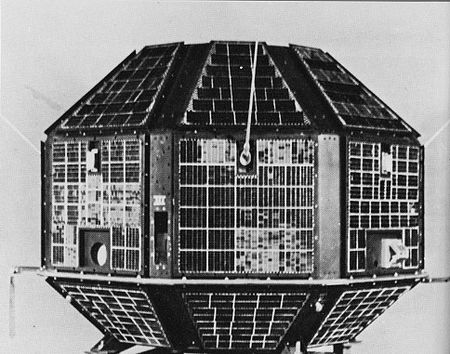In 1975, the Indian Space Research Organization (ISRO) built India's first satellite, Aryabhata which was launched by the Soviet Union. Aryabhata was a test project for India to gain experience in the construction and launching of satellites. It had an orbital period of about one hundred minutes and the orbit reached a maximum altitude of about three hundred and fifty miles. It's instrument package conducted experiments in X-ray astronomy, aeronomics and solar physics. A power system malfunction ended the mission after about sixty orbits.
During the 1970s, the ISRO worked on the development of an Indian launch vehicle because India did not want to be dependent on other nations to launch satellites. The Satellite Launch Vehicle was the first result of this project. It was designed to reach altitudes of over two hundred and fifty miles and could carry a payload of about ninety pounds. The SLV was a four stage solid fuel rocket. The first SLV was launched from the new launch facility at Sriharkiota in 1979.
In 1979, India used a SLV-3 to launch the Rohini Technology Payload, the first Indian satellite carried into space by an Indian launch vehicle. The SLV-3 was unable to place the satellite into the intended orbit. The Rohini Technology Payload was the first of a series of four satellites. In 1980, the RS-1 was launched successfully on a SLV-3. It had instruments to return data on the fourth stage of the SLV-3. It's mission lasted for twenty months. In 1981, the RS-D1 was carried into space by a SLV-3 but did not reach its intended orbit. It carries a camera to test remote sensing applications and its mission only lasted nine days. In 1983, the RS-D2 was launched with a SLV-3. During its seventeen month mission, its Smart sensor camera took over twenty five hundred pictures in both the visible and infrared band.
In 1981, the Ariane Passenger Payload Experiment satellite was built to gain experience in communication satellites in geosynchronous orbit. It was carried into orbit by the Ariane-1, a launch vehicle developed by the European Space Agency launched from French Guiana. In 1982, a U.S. Delta 3910 PAM-D launch vehicle carried the first satellite of the Indian National Satellite System (INSAT) into geosynchronous orbit. The INSAT is a multipurpose geo-stationary satellite for use in telecommunications, broadcasting, meteorology and search and rescue. It only functioned for six months.
Throughout the 1980s, India continued to launch its own satellites and to have satellites launched by other nations. The Soviet Union launched a pair of Bhaskara remote sensing satellites, one in 1979 and the other in 1981. They were placed in orbit by C-1 Interkosmos launch vehicles. The United States continued to provide and launch INSAT communication satellites which permitted a revolution in television programming delivery in India. India attempted to launch two members of the Stretched Rohini Satellite Series (SROSS) but both failed to achieve orbit.
India's first indigenously built satellite, the Aryabhatta:
